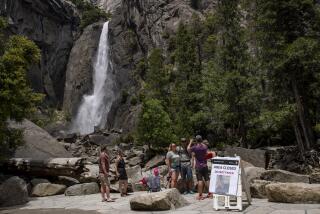Ambitious plan would remake Yosemite National Park
The majestic landscape of Yosemite National Park — carved out of granite and shaped by powerful natural forces over the eons — is timeless and untouchable.
Other attractions in the park … not so much.
Some of Yosemite’s much-loved amenities, including swimming pools, bike, horse and raft rentals, and an ice skating rink, would be jettisoned under a plan to restore the Merced River corridor to a more natural state.
The Merced Wild and Scenic River Plan would reconfigure much of the Yosemite Valley by removing or relocating familiar concessions. Park officials also hope to reduce traffic that often transforms the heart of Yosemite from natural wonder to parking lot.
The National Park Service’s proposal, which would cost $235 million over the next 15 years, seeks to balance the twin aims of improving infrastructure and preserving nature. The plan would restore more than 200 acres of meadows, install boardwalks and new trails, reroute automobile traffic, create a pedestrian underpass at Yosemite Falls and increase the number of camping sites, hotel rooms and parking spots.
But, unlike much of Yosemite, the plan is not yet set in stone. The park service has until July to finalize its plans, which could become official by fall.
Most of the changes are designed to protect the Merced River and its flood plain and restore the river’s corridor and habitat. Many of the buildings and concessions would be removed not because they are unwanted but because they are too close to the river, park officials said.
The Merced River, which flows through the most-visited sections of the park, was designated a national wild and scenic river in 1987, affording it and its environs a high level of protection. A catastrophic flood 10 years later took out roads, bridges and treasured riverside campgrounds.
Since the flood, various plans put forth by Yosemite officials to restore facilities and the river have been challenged in court by groups seeking less commercialization. Three previous plans have been invalidated. The park has spent more than $23 million to resolve planning and litigation issues.
The current blueprint is shaped in part by an appeals court judge’s admonition to park administrators to eliminate development near the Merced River or, failing that, to ensure that activities allowed in the narrow river corridor will do no environmental harm.
In dozens of public meetings over four years, Yosemite officials got an earful, from families arguing that the proposal eliminates much-loved attractions and needed services and from conservation groups criticizing it for elevating commercial activity over other forms of recreation.
“There has been a flurry of public comment, but the biggest concerns across the spectrum are about the ice rink and bike rentals,” said Kathleen Morse, Yosemite’s chief planner.
Morse said the strong response has officials considering constructing a temporary winter rink on a parking lot and allowing bicycle rentals in the valley via small kiosks.
Visitors may still bring their own bikes and rafts into the park.
Nostalgia is not likely to save the swimming pools at the Yosemite Lodge and Ahwahnee Hotel or the rafting rentals on the Merced River. Gone, too, would be the Yosemite Art Activity Center and a handful of grocery stores and gift shops deemed duplicative or situated in the river corridor.
“Generations have used these facilities,” Morse said. “We understand they care about them. It’s a balance.
“The whole reason we are struggling with this is we want people to have maximum enjoyment of the park,” she added. “The park is for the people. We want them to bring their rafts, bring their bikes, bring their gear. There will be no change of the suite of activities they can enjoy.”
Park advocates applaud the plan as a difficult but necessary compromise.
“Ninety-nine percent of the recreational uses will remain, and they propose to take out only 1% of commercial use,” said Ron Sundergill, regional director of the National Parks Conservation Assn. “It’s a good plan. Hopefully, it will not get litigated again.”
Public comments included much frustration with traffic congestion in a park that hosts about 4 million visitors a year. Because of inefficient traffic routing and insufficient parking, many tourists resort to experiencing Yosemite exclusively from behind the windshield of their cars.
Morse said it’s the No.1 gripe among visitors, who must negotiate traffic-clogged roads in a narrow valley.
“We’ve had days when 3,000 people came into the park and literally sat in their cars — their feet were not on the ground, they were not on trails, they were not in parking lots,” she said. “They were simply trying to work their way through the valley to get back out.”
In response, some traffic will be rerouted, traffic circles will be added and a 200-space remote parking lot is planned at El Portal, Morse said.
While acknowledging the complexities inherent in crafting such a plan, Greg Adair, of the group Friends of Yosemite Valley, said the park’s proposal is a failure.
“What they’ve done is look at how much parking they can squeeze in the Yosemite Valley,” said Adair, whose group was the lead plaintiff in two lawsuits challenging previous plans. “The plan should be focused on river-related recreation: bird watching, swimming, wading and hiking. It’s not staying overnight in a hotel.”
More to Read
Sign up for Essential California
The most important California stories and recommendations in your inbox every morning.
You may occasionally receive promotional content from the Los Angeles Times.











